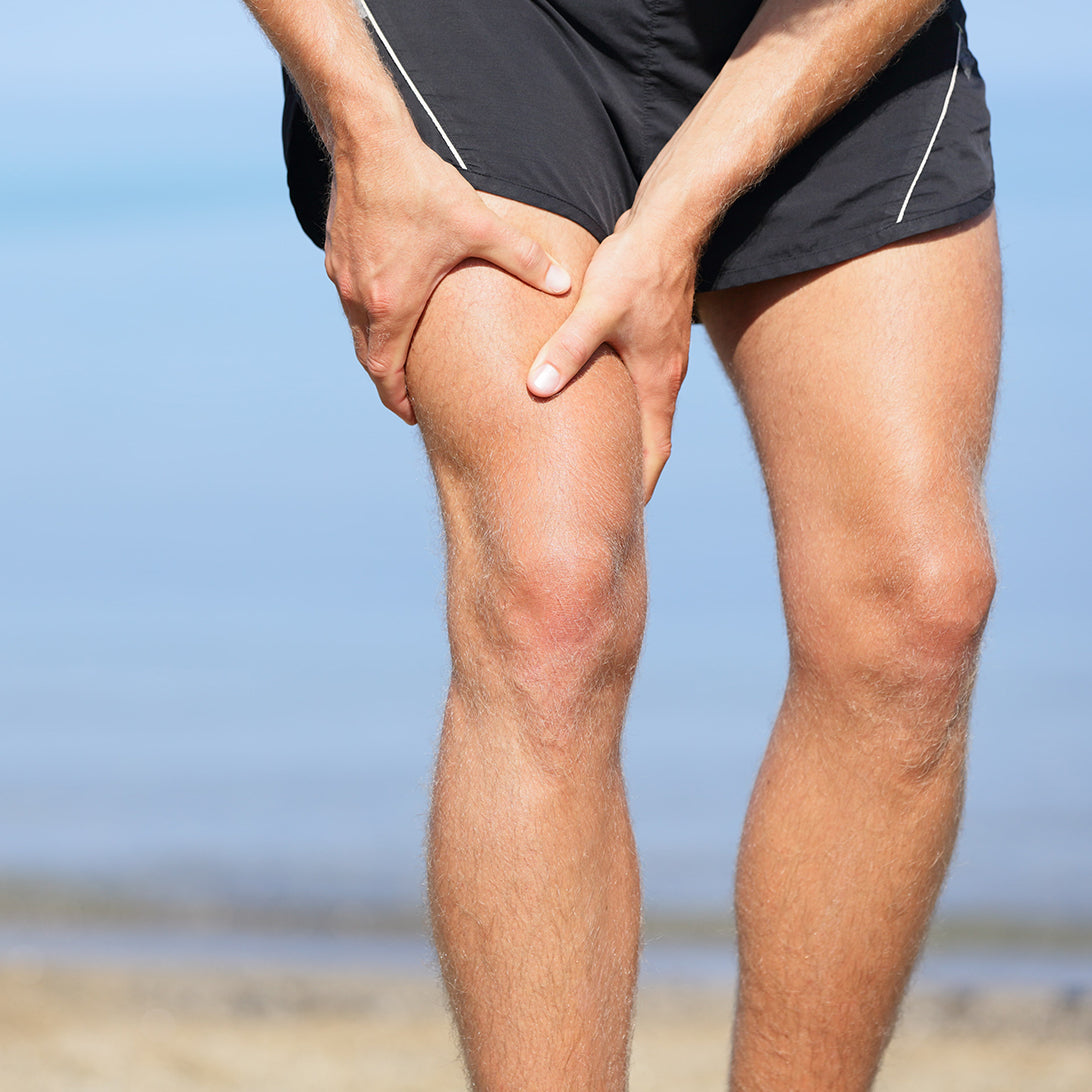Muscle knots can be pesky problems that give us pain and discomfort if they're not treated properly.
A lot of us have experienced them at least once, whether due to over-exertion during exercise or sitting too long at work or home. Knowing how to treat them is essential so as not to experience future episodes or worsen the existing condition, especially when sustained over time.
In this article, we will roll out everything you need to know about knots in your muscle. You'll get to know the causes, how to identify them, and most importantly, how to get rid of them.
So, take a few moments out of your day and let's get started with what muscle knots are.
Understanding Muscle Knots
Also known as trigger points, muscle knots are small areas of tightness in the muscles that can cause chronic pain and discomfort.
They are very common and are usually found in the neck, shoulders, back, and hips. Muscle knots can also be found in other body areas, such as the arms and legs. When these trigger points become active, they can cause pain in the area where they are located and referred pain.
Muscle knots can be caused by various factors ranging from poor posture to overuse of the muscle. In the next section, let's look at how these factors play a role in the development of muscle knots.
1. Identifying causes of knots in your muscle
Identifying the cause of your muscle knot is important in treating it.
It could be due to several factors, such as poor posture, overuse or repetitive motions, dehydration, and even emotional stress. Let's take a look at each of these causes in more detail.
Poor posture
A significant cause of muscle knots is sitting or standing in an uncomfortable position for too long. This can cause our muscles to become tense and tight, leading to knots forming.
Muscle knots from poor posture can be especially painful, as the muscles constantly pull in the wrong direction.
Moreover, poor posture can lead to other issues, such as back pain, neck pain, and even headaches.
Overuse or repetitive motions
Another common cause of muscle knots is overuse or repetitive motions.
This happens when we make the same motion repeatedly, such as typing on a computer for long periods, playing a musical instrument, or doing manual labor.
These activities can tense your muscles and lead to knots forming in the affected area. Furthermore, overuse can also lead to inflammation in sore muscles, making the knots even more painful.
Stress and tension
Putting stress on our bodies can also lead to muscle knots.
When we're stressed, our muscles tense up as a way of protecting us from potential danger. This tension can cause knots in the affected area, leading to pain and discomfort.
Muscle knots from tension occur when we're feeling anxious or overwhelmed and can be especially painful if the knots are in the neck or back.

Injury or trauma
Muscle knots can also develop as a result of an injury or trauma.
When we experience an injury or trauma, such as a fall or car accident, our muscles can become tense and tight to protect the affected area. This can lead to knots forming in the muscles, which can cause pain and discomfort.
Furthermore, suppose the injury is severe enough. In that case, it can cause muscle inflammation, making the knots even more painful.
Muscle knots can be difficult to identify, as they often feel like a general soreness or tightness. To help you pinpoint the exact location of your knot, we will look at some of the common signs and symptoms of muscle knots in the next section.
2. Pinpointing areas of muscle knots in your body
Identifying knots in your muscle can be tricky, as they often feel like a general soreness or tightness. To help you pinpoint the exact location of your knot, there are some common signs and symptoms to look out for.
Pain or tenderness
Muscle knots can cause localized pain or tenderness in the affected area. This pain can range from a dull ache to a sharp, stabbing sensation.
If you feel pain in a specific area, it could be a sign of a muscle knot. Start by running your hands over the affected area and look for tender or painful areas when touched. Once you've identified where the knot is located, you can start treating it.
Stiffness
Muscle knots can also cause stiffness in the affected area, making it difficult to move or stretch. This stiffness can be especially noticeable after periods of inactivity, such as when you wake up in the morning.
Limited range of motion
If you have a knot in your muscle, you may find it hard to move the affected area. This is because the knot can limit your range of motion, making it difficult to move or stretch the muscle.
So, these are some of the common signs and symptoms of a muscle knot. Identifying where muscle knots are located in your body is essential in treating them. Once you've identified where the knot is located, you can start treating it.
Treating muscle knots can be done in several ways that are safe and effective. In the next section, we'll look at each of these methods in more detail.
Treating and Relieving Pain from Knots in Your Muscle
When it comes to treating muscle knots, you can use a few different methods.
These methods are safe and effective and can help to reduce the pain and discomfort associated with knots in your muscle. Some of them include the following:
1. Reduce inflammation with ice or heat therapy
Reducing inflammation with ice or heat therapy is a great way to treat muscle knots.
Ice can help reduce swelling and inflammation, while heat helps to relax tight muscles and increase circulation. For best results, use an ice pack on the affected area for 15-20 minutes at a time, several times a day.
On the flip side, heat therapy is another way to reduce inflammation and relax the muscles. You can use a heating pad or hot water bottle on the affected area for 15-20 minutes at a time, several times a day.
2. Recovering with proper rest and gentle stretching exercises
Eliminating pain from muscle knots can also be done with adequate rest and stretching exercises.
Resting the affected area is essential to allow the muscles to heal and recover. Additionally, stretching exercises can help to reduce muscle soreness and improve flexibility.
Stretching exercises should be done gently and slowly, as too much force can cause further injury or pain. It's also important to focus on breathing while stretching, as this can help to relax the muscles and reduce tension.
3. Incorporating percussion massage into your self-care routine
Incorporating percussion massage into your self-care routine is another great way to treat muscle knots in your body.
The daily use of a massage gun helps to increase circulation and reduce muscle tension what will contribute to relax the muscles.
Massage gun can be used at home every day for best results. It's important to be gentle and listen to your body while performing regular exercises, as too much pressure can cause further injury or intense pain.
4. Using essential oils
Essential oils can also be used to treat muscle knots in your body. Essential oils such as lavender, peppermint, eucalyptus, and rosemary have anti-inflammatory properties that can help reduce inflammation and pain associated with muscle knots.
Using essential oils is accessible at home and can be done several times a week for the best results. Simply add a few drops of the essential oil of your choice to a carrier oil, such as coconut or jojoba oil, and massage it into the affected area.
While these methods can help to reduce pain and discomfort associated with muscle knots, preventing them in the first place is key. Explore just how you can do this in the next section!
Effective Ways to Prevent Knots in Your Muscle
Preventing knots in your muscle tissue is just as important as treating them. Here are a few tips to help you out:
1. Keep your muscles hydrated to facilitate healthy movement and flexibility
Drinking plenty of water is essential for preventing knots in your muscles.
When dehydrated, your muscles become more prone to tightness and tension, which can lead to knots. Make sure to drink at least 8 glasses of water daily to keep your body hydrated, and your muscles relaxed.
Avoiding excessive caffeine and alcohol can also help prevent muscle knots, as these substances can cause dehydration.
2. Practice proper posture while sitting, standing, and sleeping at all times
Practicing good posture is another way to prevent knotted muscles.
As we mentioned earlier, sitting or standing in awkward positions for too long can cause your muscles to become tense and tight, leading to knots.
So, stand up and move around every 30 minutes to keep your muscles relaxed and prevent knots from forming. Also, ensure that you sit and stand in a neutral position with your shoulders back and your head up.
3. Take breaks when doing strenuous activities
When engaging in any strenuous physical activity, taking regular breaks is essential to allow your muscles to rest and recover. This can help reduce muscle tension and tightness, which can lead to knots if left unchecked.
Taking breaks can also help prevent fatigue and exhaustion from setting in, which can further increase the risk of muscle knots.
4. Eat a balanced diet to keep your body strong
Eating a balanced diet is important in preventing knots in your muscles. Eating various nutrient-rich foods can help keep your muscles strong and healthy, reducing the risk of knots forming.
Focus on eating plenty of fruits and vegetables, whole grains, lean proteins, and healthy fats. These foods provide essential vitamins and minerals necessary for muscle health and function. Additionally, get enough calcium and magnesium, as these minerals can help reduce muscle tension and tightness.
5. Avoid repetitive motions
Another way to prevent muscle knots in your body is to avoid repetitive motions.
Repetitive motions, such as typing or using a mouse for long periods, can cause your muscles to become tense and tight. This can lead to knots forming if left unchecked.
So, make sure to take regular breaks when engaging in repetitive motion activity and stretch your muscles regularly to keep them relaxed and prevent knots from forming.
6. Implement a regular stretching routine, focusing on areas with chronic tightness
Implementing a regular stretching routine is essential in preventing knots in your muscles. Stretching helps to relax your muscles and increase their flexibility, reducing the risk of knots forming.
Focus on areas that tend to be chronically tight, such as your neck, shoulders, back, and hips. Spend extra time stretching these areas as they are more prone to tension and tightness, which can lead to knots.
Also, stretch before and after any strenuous physical activity to relax your muscles and prevent knots from forming.
Now that you know how to prevent muscle knots, it’s time to start implementing these tips into your daily routine. If after trying these tips you still experience knots in your muscles, then it could be a sign of a more serious underlying issue.
In the next section, we'll briefly explore when you should see a doctor for knots in your muscles.
When to Seek Medical Help for Knots in Your Muscle
If you experience persistent or severe muscle knots, it may be time to seek medical help.
Muscle knots can sometimes be a sign of an underlying medical condition, such as fibromyalgia or chronic fatigue syndrome.
Your doctor can help diagnose the underlying cause of your muscle knots and recommend treatments to help reduce their severity. Treatments may include medications to help reduce muscle tension and tightness.
Physical therapists can also help you learn proper stretching techniques to help reduce the risk of knots forming in your muscles.
It is essential to take muscle knots seriously and seek medical help if needed. Doing so can help prevent them from becoming worse and causing further issues.
Frequently Asked Questions
After reading everything above, you likely have many unanswered questions.
In this section, we have tried to answer many of them, from the most common to the more complex. Let's check out some of the frequently asked questions about this topic:
Are muscle knots always painful?
Yes, muscle knots are usually painful.
The pain associated with a muscle knot can range from mild to severe and can be localized or widespread. Additionally, the pain may be sharp or dull and may worsen with movement or pressure.
Muscle knots can also cause stiffness and tightness in the affected area, further contributing to discomfort. If you experience persistent or severe pain related to a muscle knot, it is crucial to seek medical help.
You may be experiencing a knot in one or more of your muscles. This can be painful and uncomfortable, so it is essential to understand what might be causing the knots and what you can do to eliminate them.
Is there any pain medication I can take for my sore muscle knots?
Yes, some medications can be used to treat knots in your muscles.
These medications can help reduce muscle tension and tightness, which can help prevent knots from forming or worsening.
Commonly prescribed medications include non-steroidal anti-inflammatory drugs (NSAIDs), muscle relaxants, and corticosteroids. It is crucial to speak with your doctor before taking any medication for muscle knots.
What activities should I avoid if I have a muscle knot?
If you have a muscle knot, avoiding activities that may aggravate the area is essential.
High-impact activities such as running or jumping should be avoided, as these can put additional strain on the affected muscle. Additionally, any activity that requires repetitive motions should be avoided, as this can lead to further tension and tightness in the area.
It is also important to avoid any activities that cause you muscle pain or discomfort.
What fitness tools can I use to eliminate knots in my muscle?
Fitness tools can be a great way to help eliminate knots in your muscles. Foam rollers, massage guns, and stretching bands are all excellent tools that can help reduce tension and tightness in the affected area.
Using these tools can help to break up the knots in your muscle and increase blood flow to the area, which can help reduce pain and stiffness. Additionally, using a foam roller or massage gun can also help to improve flexibility and range of motion in the affected area.
It is essential to use caution when using fitness tools for muscle knots, as they can be painful if used too aggressively. Start slowly and gradually increase the pressure as needed.
Conclusion
Knots in your muscles can be both annoying and painful, but luckily, they are treatable with self-care and basic physical therapy methods like stretching and massage.
Understanding what's causing the knots is also essential so you can avoid the same thing happening again or re-triggering existing tension points when exercising or doing everyday activities.
There are also risk factors associated with having a knot in your muscle, so make sure that you consult a professional if the pain persists for longer than the expected time frame. We hope you now have a better understanding of what muscle knots are and how to treat them.
If you have any further questions, please don't hesitate to leave a comment or contact your doctor




